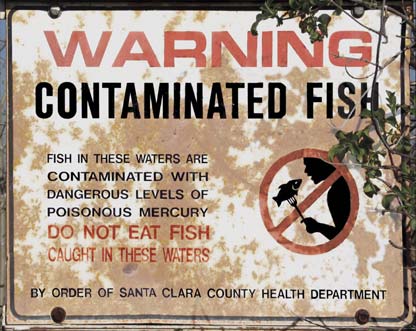General Discussion
Related: Editorials & Other Articles, Issue Forums, Alliance Forums, Region ForumsCoastal fog linked to high levels of mercury found in mountain lions, study finds
ScienceDaily / 11-26-19
Marine fog brings more than cooler temperatures to coastal areas. Researchers at UC Santa Cruz (California) have discovered elevated levels of mercury in mountain lions, the latest indication that the neurotoxin is being carried in fog, deposited on the land, and making its way up the food chain.
Concentrations of mercury in pumas in the Santa Cruz Mountains were three times higher than lions who live outside the fog zone. Similarly, mercury levels in lichen and deer were significantly higher inside the fog belt than beyond it.
Mercury levels found in pumas are approaching toxic thresholds that could jeopardize reproduction and even survival, according to the researchers.
SNIP
Although mercury levels in fog present no health risk to humans, the risk to terrestrial mammals may be significant. With each step up the food chain, from lichen to deer to mountain lions, mercury concentrations can increase by at least 1,000 times ...
FULL STORY: https://www.sciencedaily.com/releases/2019/11/191126121138.htm
Heartbreaking news
MineralMan
(146,288 posts)The coastal mountain ranges in California were the location of numerous mercury mines in the 19th century and even later. The serpentine deposits in those mountains have veins and other deposits of cinnabar, the primary ore of mercury in them. There were mines all along the coastal range, supplying mercury to the gold miners in the Sierra Nevada foothills.
Some streams from those mountains show cinnabar staining, even in areas where mining didn't take place. So, the mercury that is showing up in the fog could well be from those sources in the coastal mountains, delivered by stream water to the ocean.
Those same streams are drinking water sources for the animals in the coastal ranges, as well.
Perhaps a little more research might lead to a different conclusion as to the source of the mercury in the land animals.
The coastal range is also in the fog zone, but the mercury in the hills there comes from terrestrial sources, not the fog. It might be a more complex equation than the researchers realize.
https://www.dailybreeze.com/2009/09/17/abandoned-central-california-mercury-mines-continue-to-pollute/
Brother Buzz
(36,423 posts)a strong mountain lion population (we call pumas mountain lions in this region). It would be interesting (and good science) to do a study to compare the two populations.
MineralMan
(146,288 posts)I think the study reported on in the OP neglected that variable. I've visited some of the long-closed mercury mines to collect cinnabar and native mercury specimens. At one time, California supplied much of the world's mercury from those mines.
I suspect that most younger researchers are not even aware that mercury was mined in that region long before they were born.
dalton99a
(81,475 posts)
Almaden Quicksilver County Park
MineralMan
(146,288 posts)it also is in the environment from natural sources. The coastal areas of California are a rich source of mercury. It has been leaching out of the mountains along the Pacific coast since forever, almost. The mining made it worse, of course, but I suspect that pinnacle predators in that region have always had high mercury levels in their bodies.
Backseat Driver
(4,392 posts)From Preface by Achim Steiner UN Under-Secretary General
and Executive Director of UNEP (2006-2016)
The World Health Organization has concluded there are no safe
limits in respect to mercury and its organic compounds and the
impacts of mercury on human health have been known for centuries if not millennia.
Achim Steiner - Per Wikipedia:
Achim Steiner (born 17 May 1961) is an environmentalist, of Brazilian-German ancestry, who currently serves as the Administrator of the United Nations Development Programme. Before joining UNDP, he was Executive Director of the United Nations Environment Programme UNEP (2006–2016), and director of the Oxford Martin School (2016–2017). He has also served as Director General of the International Union for Conservation of Nature (IUCN) and Secretary-General of the World Commission on Dams.
https://wedocs.unep.org/bitstream/handle/20.500.11822/27436/mercury_timetoact.pdf?sequence=1&isAllowed=y
maxsolomon
(33,327 posts)"Headlines I never imagined I'd ever read".
MuseRider
(34,108 posts)"Although mercury levels in fog present no health risk to humans." Somebody explain to me how one mammal, living in the same area of other mammals will not suffer the risks of breathing the same air or absorbing the poison through the skin or eating eventually food that has been contaminated with it but will not be at risk? I kept reading and still do not understand how humans (mammals) doing the same thing as the affected mammals are excluded. Maybe I am missing something here?
mopinko
(70,090 posts)the fog could contaminate food crops, and have it show up in humans.
but they are talking about it being taken up by lichens, eaten by deer, eaten by lions.
Auggie
(31,167 posts)Volaris
(10,270 posts)I thought mountain lions with mercury now possessed the power to control the weather.
Took an extra second to realize how it was terrible in the other direction
Poor kitties...
Boxerfan
(2,533 posts)I lived in Portola Valley Ca. & the mines were not far away I don't remember where. But I still remember walking through the mines & a old timer used the term 'Two Bits" . I also brought home a chunk of Cinibar-and with my Mom's ok put it in a dry pot on the stove. it indeed sweated out Mercury.
Oh those were the days....